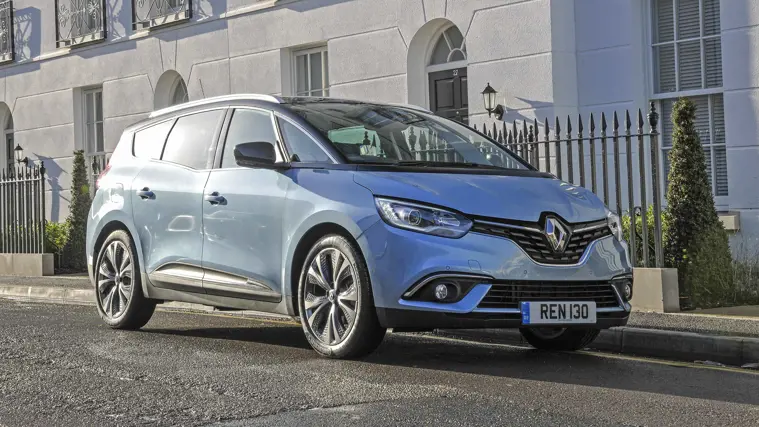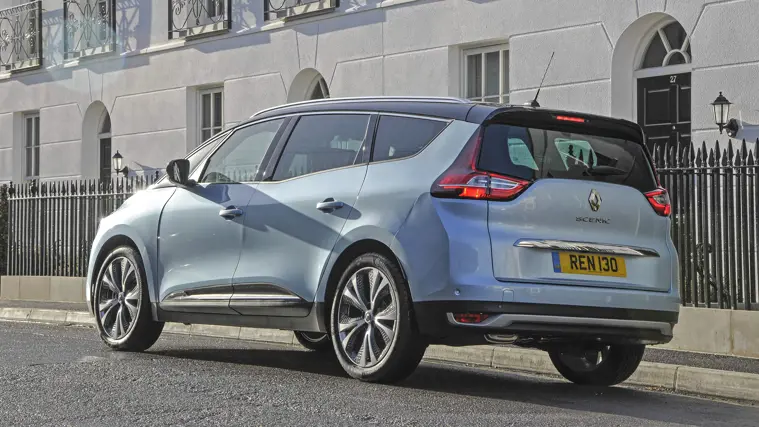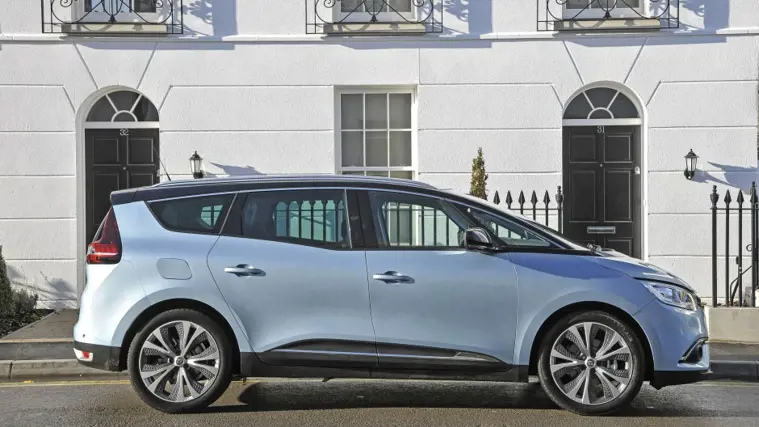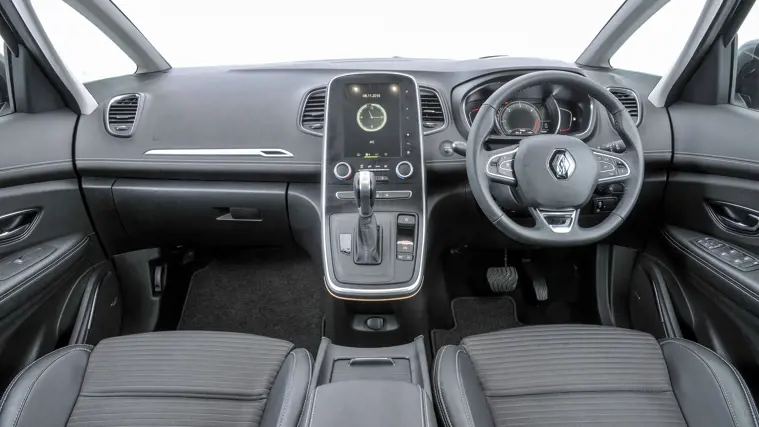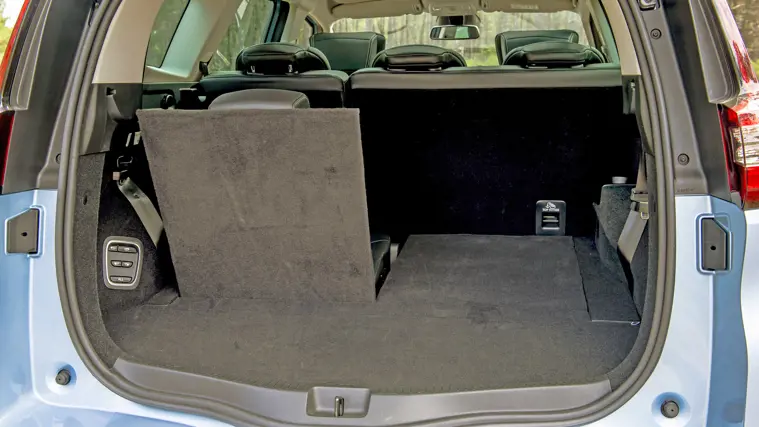Renault Grand Scenic (2016-2020) Review
The seven-seat Renault Grand Scenic looks striking inside and out, but the rearmost seats aren't the most spacious
Strengths & weaknesses
- Lots of standard technology
- Comfortable, even with big wheels
- Doesn't look like a boxy people carrier
- Restricted legroom in the back row
- Smaller diesels feel underpowered
- Distracting touchscreen media system
Traditionally, it takes a brave car buyer to admit that they have arrived at a stage in life where a people carrier - or Multi-Purpose Vehicle (MPV) - is required.
It usually happens when the brood has swollen to two or three and these children are old enough to demand that friends tag along for the ride. As a result, the ability to transport seven human beings, plus pets and other family paraphernalia becomes an absolute necessity.
Unfortunately, MPVs haven't always been easy on the eye and Renault's early Scenic models tended to look like a strange intergalactic blimp with four tiny wheels shoved in each corner.
As a result, many buyers have stepped away from MPVs in their droves, attracted by the chunky off-road styling of numerous seven-seat Sports Utility Vehicles (SUVs), meaning Renault has had to drastically alter the design of its latest Grand Scenic in an attempt to win back customers.
Part of this transformation comes in the form of enormous 20-inch alloy wheels, a rakish roofline and striking LED lights.
The result is generally pleasing and Renault engineers have worked hard to ensure those massive wheels don't affect the pleasant on-road manners and smooth ride that an MPV should offer its occupants.
Better still, the interior comes as standard with some impressive media kit, including a large touchscreen media system that deals with most of the car's functionality, DAB radio and an extensive list of semi-autonomous driver aids, such as front and rear parking sensors, designed to take the strain out of everyday life. The trouble is, forcing the driver to prod the screen for even basic controls can be a huge distraction - especially in a car where distractions aren't likely to be in short supply, considering how many children can be crammed in.
Practical touches are also present, such as twin USB slots in the rear and seat-back tray tables (complete with elastic iPad holders), while Renault offers plenty of storage in the form of a central armrest cubbyhole in the front (which slides backwards and forwards) and a second drawer in the rear.
Step up the trim levels and Renault throws in electrically folding seats, which are operated via a panel in the boot and via the media system. This means the driver can quickly drop the rear seats should your beloved offspring arrive with a muddy bike for the boot.
However, as buyers tend to plump for MPVs due to their ability to swallow a vast amount of people and stuff, rather than swanky looks and gizmos, the Grand Scenic disappoints slightly here.
The second row of seats feels a bit cramped when adults are occupying the front and things get even more claustrophobic when the third row of seats is in use.
That final row of pews is also only really suitable for the smallest children and the Citroën Grand C4 SpaceTourer definitely offers more room in this area.
Regardless, the Grand Scenic drives well, with a relaxed and comfortable ride despite the addition of enormous 20-inch alloy wheels.
There's a fair bit of noise in the cabin when up to cruising speeds and it doesn't exactly respond like an F1 car when pushed hard, but the addition of several driving modes (Sport, Comfort, Eco), which alter the weight of steering, throttle response and engine noise, does mean the driver can alter the characteristics of the drive, even if it's only slightly noticeable.
Key facts
| Warranty | 4 years / 100,000 miles |
|---|---|
| Boot size | 233 litres (596l with third row folded) |
| Width | 1866mm |
| Length | 4634mm |
| Height | 1655mm |
| Tax | From B (£20 a year) to E (£130) |
Best Renault Grand Scenic for...
Best for Economy – Renault Grand Scenic Expression+ dCi 110
Cheap to buy and cheap to run, this entry-level diesel returns an impressive claimed fuel economy figure of 70.6mpg.
Best for Families – Renault Grand Scenic Dynamique Nav dCi
Expect a handsome package of interior toys, respectable fuel economy, strong performance and a price tag that won't break the bank.
Best for Performance – Renault Grand Scenic Dynamique S dCi 160
The beefiest diesel engine is among the most expensive but it sees the 0-62mph sprint time drop to 10.7 seconds and a top speed increase to 124mph. It's not exactly fast but it's the speediest of the bunch.
One to Avoid – Renault Grand Scenic Signature Nav dCi 160
It may feature all the bells and whistles but this top-spec model is very expensive. Plus, those extra performance gains offered by the more powerful engine are barely noticeable.
Understanding Renault Grand Scenic names
Trim level Dynamique Nav
There are four trims in total, each one offering a greater amount of interior comfort, technology and convenience features. But each level comes at a higher price.
Engine dCi 100
Both petrol and diesel engines are offered, the former labelled TCe, the latter dCi. The petrol is offered in two states of tune (115 or 130hp), while the diesel is offered in two capacities and three states of tune (110hp, 130hp and 160hp).
Gearbox 6-speed manual
6-speed shows that the car has six gears. A seven speed EDC, or Electronic Dual Clutch, transmission is available to those who prefer to live with an automatic 'box.
Renault Grand Scenic Engines
Petrol: TCe 115, TCe 130, Diesel: dCi 110, dCi 130, dCi 160 EDC, dCi 110 Hybrid Assist (from Spring 2017)
Those familiar with Renault's current range of cars will be well versed in the French manufacturer's simple range of petrol and diesel engines.
The petrol offering is a 1.2-litre unit that comes in two states of tune. It is a strong contender for those who may not be travelling long distances on a regular basis, as it offers decent performance without compromising fuel efficiency or CO2 emissions.
Stick with the 130hp petrol and you'll enjoy a punchy engine that feels sprightly around town and does a respectable job of hauling the Grand Scenic's mass around without too much fuss.
On the other hand, diesel power comes either as a 1.5-litre model developing 110hp, or a 1.6-litre unit that develops 130hp or 160hp. All of the aforementioned powerplants are fairly refined, although the lower-powered version does feel a bit weedy, especially when accelerating hard or with lots of passengers and luggage on board.
The most powerful diesel engine might sound appealing but it is only offered with the EDC automatic gearbox and it only comes in the highest Signature Nav trim level, which means it's expensive.
The performance gains aren't really worth the extra money. Stick with the dCi 110 EDC if you really have to have an auto 'box; it represents much better value for money.
A dCi Hybrid Assist model arrived in 2017 and it fuses a 110hp diesel engine with a 10kW electric motor and 48-volt battery. The result is a reduction in fuel consumption and emissions, as well as improved performance thanks to the additional shove from the electric motor.
It cost around £1,000 more than the standard diesels, somewhat offsetting any fuel savings.
Renault Grand Scenic Trims
Expression+, Dynamique Nav, Dynamique S Nav, Signature Nav
Expect to be presented with four distinct trim levels when it comes to buying your new Renault Grand Scenic, but don't immediately dismiss the 'entry level' Expression+ models, as these come with an impressive amount of standard kit.
Goodies include a safety suite that contains lane-departure warning, traffic sign recognition, Pedestrian Detection and Emergency Brake Assist, as well as a speed limiter and hill start assist.
Those enormous 20-inch alloy wheels also come standard across the range, which is a first for the MPV market. As a result, engineers have designed a special tyre, which is much thinner than rival offerings to ensure fuel efficiency isn't adversely affected. Expect to have less choice and potentially higher bills when it comes time to replace these, though.
Expression+ models also come complete with a seven-inch touchscreen that handles DAB radio, Bluetooth music and hands-free smartphone pairing.
However, step up the trims to Dynamique Nav and customers get the aforementioned sliding centre console with USB slots for rear passengers, leather and cloth upholstery, the one-touch electronic folding seats and an R-Link media system that boasts TomTom sat-nav.
Dynamique S Nav adds a panoramic sunroof and additional interior trim flourishes, as well as a premium Bose sound system, while the top-spec Signature Nav models welcome full LED headlights, electrically adjustable seats (with massage functions in the front) and striking 'Quartz' alloy wheels.
Renault Grand Scenic Reliability and warranty
This model didn't feature in the latest Auto Express Drier Power reliability survey, but it feels well enough put together and previous generations have performed adequately.
Better still, the 100,000-mile/four-year warranty goes beyond many rivals, offering an additional year of coverage and an extra 40,000-miles (or whatever comes first).
Used Renault Grand Scenic
The Renault Grand Scenic has long been a favourite amongst buyers looking for bags of space in which to transport the family and as such, there are plenty on the used market to choose from.
This means that second-hand cars don't exactly hold on to their original value particularly well and this is compounded by the fact that the majority of buyers now prefer chunky SUVs to the ageing people carrier. As a result, new buyers may get less back when they come to sell, but this is good news for those buying used versions, as they'll have less to pay.

